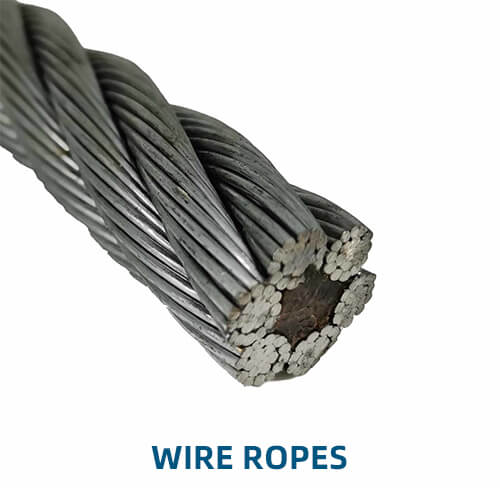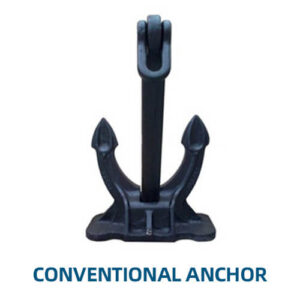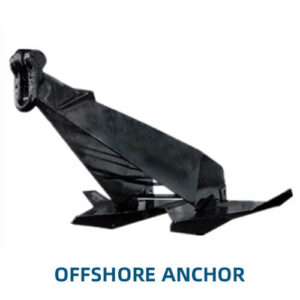Key Features of Wire Ropes:
- Construction and Design:
- Material: Wire ropes are typically made from high-tensile steel, stainless steel, or galvanized steel, providing excellent strength and resistance to corrosion. Stainless steel is particularly favored for its superior corrosion resistance in marine environments.
- Strands and Cores: A wire rope consists of several strands of wire twisted around a central core. The strands themselves are made up of smaller wires twisted together. The core can be made of fiber (natural or synthetic), wire, or an independent wire rope core (IWRC), each offering different benefits in terms of flexibility and strength.
- Lay Types:
- Right Regular Lay: The wires in the strands are twisted to the right, and the strands are laid to the right as well. This is the most common type of lay.
- Left Regular Lay: Wires are twisted to the left, and strands are also laid to the left.
- Lang Lay: The wires are twisted in one direction, while the strands are laid in the opposite direction, providing more resistance to abrasion and better performance in certain applications.
- Types of Wire Ropes:
- 6×19 Classification: Composed of 6 strands with 19 wires per strand. This type offers a good balance between flexibility and abrasion resistance and is commonly used in lifting and rigging applications.
- 6×36 Classification: Has 6 strands with 36 wires per strand, providing more flexibility than the 6×19 rope, making it suitable for applications where bending around small diameters is required.
- 8×19 Classification: Made of 8 strands with 19 wires per strand, offering more flexibility and is often used in hoisting and lifting operations.
- Compacted Wire Ropes: These ropes undergo a compaction process where the wires and strands are compacted to increase the rope’s strength, resistance to abrasion, and lifespan.
- Rotation-Resistant Wire Ropes: Designed to minimize rotation under load, making them ideal for use in cranes and other lifting equipment where rotation could be dangerous or undesirable.
- Applications:
- Lifting and Hoisting: Wire ropes are extensively used in cranes, winches, and hoists for lifting heavy loads in both maritime and industrial applications. Their high tensile strength and flexibility make them ideal for these tasks.
- Mooring Lines: Wire ropes serve as mooring lines to secure vessels to docks or offshore platforms. Their strength and ability to withstand the dynamic forces of waves and tides are critical in these applications.
- Towing: In towing operations, wire ropes are used to connect tugboats to other vessels or barges, providing a reliable and durable connection.
- Anchoring: Wire ropes are sometimes used in anchoring systems, especially in deep-water applications where their strength and ability to handle significant loads are required.
- Rigging: In marine construction and offshore platforms, wire ropes are used in various rigging applications, including the suspension of loads and the assembly of structures.
- Performance Characteristics:
- Strength: Wire ropes offer exceptional tensile strength, capable of handling very high loads without breaking. The strength of a wire rope depends on its construction, material, and diameter.
- Durability: Wire ropes are highly durable and resistant to abrasion, making them suitable for use in harsh marine environments. Galvanized and stainless steel options provide added protection against corrosion.
- Flexibility: The flexibility of a wire rope is determined by the number of wires in each strand and the type of core. Ropes with more wires per strand are generally more flexible but may wear faster due to the smaller wire diameter.
- Fatigue Resistance: Wire ropes are designed to withstand repeated bending and flexing without failure. The fatigue resistance of a rope is an important factor in applications involving continuous movement, such as in cranes or winches.
- Maintenance and Care:
- Regular Inspection: Wire ropes should be regularly inspected for signs of wear, corrosion, broken wires, kinks, or other damage. Early detection of issues can prevent failures and extend the rope’s service life.
- Lubrication: Regular lubrication is necessary to protect wire ropes from corrosion and reduce friction between the wires, which can cause internal wear. Lubricants should be applied according to the manufacturer’s recommendations.
- Storage: Wire ropes should be stored in a dry, well-ventilated area to prevent rust and corrosion. Properly coiling or spooling the rope during storage helps maintain its integrity and prevents kinks or deformation.
- Replacement: Wire ropes should be replaced if they show significant wear, corrosion, or have a high number of broken wires. Following industry standards for rope replacement ensures safety and reliability.
- Safety Considerations:
- Load Capacity: It is crucial to use wire ropes within their rated load capacities. Overloading can lead to rope failure and potentially dangerous situations.
- Handling: Proper handling techniques, such as avoiding sudden jerks and ensuring smooth transitions over sheaves and pulleys, help maintain the rope’s integrity.
- Training: Personnel using wire ropes should be trained in proper handling, inspection, and maintenance procedures to ensure safe and effective use.
Advantages of Wire Ropes:
- High Strength: Wire ropes can handle very high loads, making them suitable for heavy-duty lifting and towing operations.
- Durability: Resistant to wear, abrasion, and environmental factors, wire ropes have a long service life when properly maintained.
- Versatility: Wire ropes are used in a wide range of applications, from lifting and towing to anchoring and mooring, providing reliable performance across various marine operations.
Considerations for Wire Ropes:
- Weight: Wire ropes are relatively heavy, which can be a disadvantage in some applications where weight reduction is critical.
- Cost: High-quality wire ropes, especially those with special coatings or constructions, can be expensive. However, their durability and performance often justify the investment.
- Flexibility vs. Strength: A balance must be struck between flexibility and strength depending on the specific application. Ropes with more strands and wires are more flexible but may not be as strong as those with fewer, thicker wires.
Wire ropes are indispensable tools in marine and industrial applications, offering a combination of strength, durability, and flexibility that is unmatched by other types of ropes or cables. Whether used in lifting, towing, or securing vessels, wire ropes provide the reliability and performance needed to handle the most demanding tasks in challenging environments.






